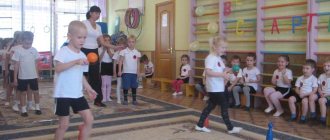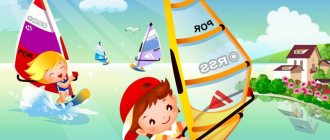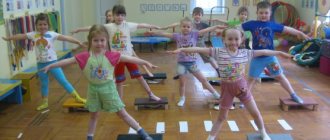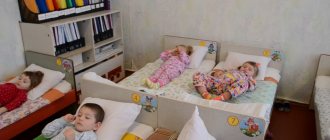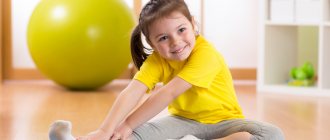Complex of morning exercises for different age groups.
Municipal state preschool educational institution
Yushinsky kindergarten
"Morning exercise complexes"
in a mixed age group
Completed by: teacher Murzova L.L.
Morning exercise complex No. 1
A cord is laid out along the hall, which divides it into two parts - “paths”. The starting line is also marked with a cord. On the opposite side of the hall, at the finish line, balls are placed according to the number of children. Younger and older children stand in a line at the starting line, with a teacher between them. At his command, the children walk towards the balls, take them and turn around. On command, children with a ball in their hands return to the starting line. Then, on command, the children roll the ball forward, energetically pushing it away from themselves in a straight direction, and catch up with it. Return to the starting line. Walking and running are repeated 2-3 times.
General developmental exercises with a ball.
- I.p. – feet shoulder-width apart, ball in both hands below. Raise the ball up, rise on your toes and stretch; return to I.P. (5-6 times)
- I.p. – feet hip-width apart, ball in bent arms in front of you. sit down; bring the ball forward; i.p.; squat hands with the ball up; I.P. (4-5 times)
- I.p. – kneeling position, ball in both hands on the floor. Rolling the ball around the body, moving it with your hands, turning to the right and left (3 times each)
- I.p. – legs slightly apart, arms at random, ball on the floor. Jumping on two legs around the ball in both directions (2-3 times).
- Walking in a column one at a time with a ball in their hands.
Morning exercise complex No. 2
Walking in a column one at a time, with the older children in front, and the younger children at a distance of about 2 m from them. Children can catch up with their elders while walking, and then again fall behind a little, as if to “stretch” (later children will learn to keep their distance). While walking, the teacher gives tasks (there may be several of them). For example, at the “Frog” signal, children stop, squat down, then get up and continue walking.
Running in all directions throughout the hall. The teacher makes sure that the children do not touch each other.
ORU.
- I.p. – feet shoulder-width apart, hands on waist. Raise the right 9left () leg, bend at the knee, arms to the sides, lower the leg, return to the i.p. (5-6 times)
- I.p. – feet shoulder-width apart, hands on waist. Tilt to the right (left) with a slow movement. Return to i.p. (3-4 times).
- I.p. – lying on your stomach, arms extended forward. Bend over, raising your torso, stretch your arms forward and slightly to the sides. Return to i.p. (5-6 times).
- I.p. – lying on your back, arms straight behind your head. Raise your legs forward - up, touch your knees with your hands. Lower your legs, return to IP. (5-6 times).
- Game task “We stomp our feet.”
Children stand in two semicircles (in subgroups) on opposite sides of the hall. The teacher stands between them - in the center of the circle. Together with the teacher, the children recite a poem and perform the appropriate actions:
We stomp our feet
We clap our hands
We shake our heads.
We raise our hands
We give up
And we run around.
After saying the last line, the children, at the teacher’s signal, turn right and run in a circle. After some time, they stop at a signal and the game is repeated. Finally, walk at a moderate pace.
Morning exercise complex No. 3
Game task “Migration of birds”. Along the hall there is a cord - a “dividing strip”. Children stand on both sides of the strip on the starting line in two lines at a distance of 1-2 steps from each other. The teacher invites the “birds” to learn to fly a little.
Children raise their arms to the sides, open by stepping (in each subgroup from the center), then lower their arms.
At the signal “the birds have flown,” the children, spreading their arms like wings, run in a straight direction to the “clearing” (beyond the conventional line). They turn around and come back. The dashes are repeated 3-4 times. Each subgroup runs at its own pace.
Open switchgear with cubes.
- I.p. – legs at the width of the foot, cubes in both hands below. Lift the cubes up through the sides, rise onto your toes; lower your hands down, return to IP. (6 times).
- I.p. – feet shoulder-width apart, cubes behind your back. Lean forward, touch your legs with cubes, or straighten up, return to standing position. (5-6 times).
- I.p. – legs at the width of the foot, cubes in the hands at the shoulders. Sit down, bring the cubes forward, arms straight. Get up, return to standing position. (5-6 times).
- I.p. – sitting in front of the cubes, legs crossed. Hold the cube with both hands. Turn your torso to the right (left), place the cube at the toe of your (right) leg, straighten up. Turn the body to the right (left), take the cube, straighten up, return to the i.p. (3 times).
- I.p. – standing in front of the cubes, hands on the belt. Jumping on two legs around the cubes in both directions (2-3 times).
- Walking randomly throughout the hall; walking in a column one at a time.
Morning exercise complex No. 4
Game task “Don’t touch me.” On two opposite sides of the hall, cubes (6-8 pieces) are placed in a row at a distance of 40 cm from one another. Subgroups are built in two lines - each in front of its own row of cubes. After explaining the task and showing the exercise, the children line up in columns. The teacher draws attention to the need to maintain distance when completing the task. At a signal, children walk and run between the blocks.
Outdoor switchgear with flags.
- I.p. – feet shoulder-width apart, flags in hands below. Raise the flags to the sides (arms straight). Lower the flags down (4-5 times)
- I.p. – feet shoulder-width apart, flags in hands behind your back. Flags to the sides (arms straight). Lean forward, cross the flags in front of you. Straighten the flags to the sides. Return to i.p. (4-5 times)
- I.p. – feet shoulder-width apart, flags in hands below. Turn your torso to the right (left), arms to the sides, wave the flags. Straighten up, return to standing position. (3 times).
- I.p. – feet hip-width apart, flags at the shoulders. Sit down and bring the flags forward. Return to i.p. (4-5 times)
- Walk with flags in your hands (both flags in one hand), waving above your head, about half a circle. Then, as they move, the children put flags in the box.
Morning exercise complex No. 5
Walking in a column one at a time: the older children are in front of them - the little ones. At the teacher’s signal “Heron!” children stop and raise their leg bent at the knee and their hands on their waist. Normal walking and repeating the task (raise the other leg. Switch to running at a moderate pace. At the signal “Butterflies!” the children wave their arms like wings. Normal walking.
ORU.
- I.p. – feet hip-width apart, hands on the waist. Hands to the sides, hands behind the head, hands to the sides. I.p. (5-6 times)
- I.p. - Same. Hands to the side; sit down, clap your hands in front of you; stand up, arms to the sides, return to standing position. (4-5 times).
- I.p. – feet shoulder-width apart, hands on waist. Hands to the side; lean forward, touch the floor with your hands. Straighten up, arms to the sides; return to IP (4-5 times)
- I.p. - stand on your knees, hands on your belt. Turn your torso to the right (left), touch your right (left) hand to your leg. Straighten up, return to standing position. (3 times).
- I.p. – legs slightly apart, arms at random. Jumping on two legs in place with a circle turn in both directions for a count of 1-8 (3-4 times).
Morning exercise complex No. 6
Walking in a column one at a time; walking and running at a moderate pace between chairs (according to the number of children), placed in a checkerboard pattern. The teacher sets the pace of walking and running using a tambourine. Walking and running exercises alternate.
Outdoor switchgear on chairs
- I.p. – sitting on a chair, legs apart, hands on the waist. Hands to the sides, behind the head, to the sides, return to IP. (4-5 times).
- I.p. – sitting on a chair, legs apart, hands on the waist. Hands to the side; lean to the right (left), touch the fingers of your right (left) hand to the floor. Straighten up, arms to the sides, return to standing position. (3 times).
- I.p. – sitting on a chair, legs together, hands resting on the edges of the seat. Raise your legs straight; lower, return to i.p. (5 times).
- I.p. – standing behind a chair, legs slightly apart, hands holding the back of the chair. Slowly sit down, leaning your hands on the back of the chair, squatting and spreading your knees to the sides. Return to i.p. (5-6 times)
- I.p. – standing behind the chairs, arms freely. Jumping around the chair in both directions (3-4 times).
- Game task “Get to your places!” At the teacher's signal, children run in all directions. At the signal “Get to your places!” Each player occupies any free chair. When repeating the game task, one chair runs away. The one who failed to take a place lost. It is carried out 2-3 times.
- Walking in a column, one at a time, around the chairs.
Morning exercise complex No. 7
Walking in a column one at a time, stopping at the teacher’s signal, running in a column one at a time.
outdoor switchgear
.
- I.p. – legs hip-width apart, arms along the body. Raise your arms to the sides, clench your hands into a fist. Return to i.p. (5-6 times).
- I.p. – legs slightly apart, hands behind your back. Sit down, bring your arms forward, clenching your hands into a fist. Get up, return to standing position. (5-6 times).
- I.p. – feet shoulder-width apart, arms along the body. Hands behind your head, tilt to the right (left) (3 times).
- I.p. – sitting, legs straight together, arms supported behind you. Raise your legs forward and up, bend your knees, straighten, return to standing position. (4-5 times)
- I.p. – lying on your back, legs straight, arms along the body. Bend your knees, clasping your arms. Straighten up. Return to i.p. (5-6 times).
- Game "Frogs - jumping". Along the hall there is a cord - a “dividing strip”. Children - “frogs” stand in ranks on the starting line (distance 1 meter). The teacher says the text:
Here are the frogs jumping along the path,
Stretching out my legs,
Kva-kva, kva-kva-kva, they jump along the path,
Stretching out your legs.
In accordance with the rhythm of the poem, children perform jumps on two legs, moving forward to the opposite side of the hall. Having reached the wall, they turn around. After a pause, the game task is repeated.
Morning exercise complex No. 8
Walking and running between objects (cubes, pins, etc.) at the command of the teacher. Each subgroup performs the exercise in its own part of the hall, separated from the other by a cord.
ORU with the ball.
- I.p. – feet shoulder-width apart, ball in bent arms near the chest. Straightening your arms, lift the ball up, stretch, and rise on your toes. Lower the ball, return to IP (5-6 times).
- I.p. - Same. Lift the ball up, lean towards your right foot, touch the floor between your right and left feet, lean towards your left foot. Return to i.p. (5-6 times).
- I.p. – sitting on your knees, the ball in front of you. Roll the ball around your body to the right, moving your hands; the same to the left (2-3 times). Each subgroup performs the exercise at its own pace.
- I.p. – lying on your back, legs straight, ball in both hands behind your head. raise your straight legs forward and up, touch your knees with the ball; return to IP (5-6 times).
- I.p. – feet hip-width apart, ball in bent arms near the chest. Jumping on two in place for a count of 1-7, for a count of 8 – jump to the right. Jump to the count of 1-7 on the spot, to the count of 8 - return to the jump. The same with jumping to the left (2-3 times).
- Walking in a column one at a time with a ball in their hands.
Morning exercise complex No. 9
Walking and running at the teacher’s signal in a column, one at a time, between objects (5-6 pieces), placed at a distance of 30 - 40 cm on opposite sides of the hall. The main attention is paid to ensuring that children do not touch objects, and at the end of the task, walk around them from the outside.
ORU.
- I.p. – legs feet-width apart, cube in right hand. Hands to the sides, up: pass the cube to the left hand; hands to the side; lower. The same when passing the cube to the right hand (4-5 times).
- I.p. - Same. Squatting, pass the cube to your left hand; stand up. The same when passing the cube to the right hand (4-5 times).
- I.p. – feet shoulder-width apart, cube in right hand. Bend over and place the cube on the floor between your legs; straighten up, put your hands behind your back. Bend over, take the cube with your left hand, straighten up, put your hands behind your back. Bend over, take the cube with your left hand, straighten up, bend over, put the cube on the floor with your left hand, etc.
- I.p. – stand on your knees, cube in your right hand. Turn your torso to the right, place the cube on the floor; straighten up, hands on your waist. Turn your torso to the right, take a cube, transfer it to your left hand. The same to the left (3 times).
- I.p. – standing in front of the cube, legs slightly apart, hands on the waist. Jumping on two legs around the cube in both directions with a short pause between turns (3-4 times).
- Walking in a column one at a time with a cube in hand.
Morning exercise complex No. 10
Walking and running at the teacher’s signal in a column, one at a time, between objects (5-6 pieces), placed at a distance of 30 - 40 cm on opposite sides of the hall. The main attention is paid to ensuring that children do not touch objects, and at the end of the task, walk around them from the outside. ORU.
- I.p. – legs hip-width apart, arms along the body. Arms forward, to the sides, forward; return to IP (5 times).
- I.p. – feet shoulder-width apart, arms up (straight). Lean forward; swing both arms forward, backward, forward. Straighten up, return to standing position. (4-5 times).
- I.p. – feet hip-width apart, hands on the waist. Sit down, arms forward, arms to the sides. Return to i.p. (4-5 times).
- I.p. – feet shoulder-width apart, hands behind your head. Turn your torso to the right, move your right arm to the side. Straighten up and return to standing position. The same to the left (3 times).
- Jumping on two legs, moving forward between objects.
- Walking in a column one at a time.
What is a mixed age group
This is a group in which children differ from each other in age and development. Most often, such groups are taught in kindergartens. To create a multi-age group, it is not enough to simply gather children from 3 to 7 years old in one place. The group requires a special educational program: children study the same material, but older ones study at an in-depth level. Teachers also delegate some of the household and pedagogical tasks to the older children: the elders help the younger ones get dressed, put away the dishes, and explain tasks. Most often, multi-age education is used in kindergartens working according to the Montessori approach or within the framework of Waldorf pedagogy.
